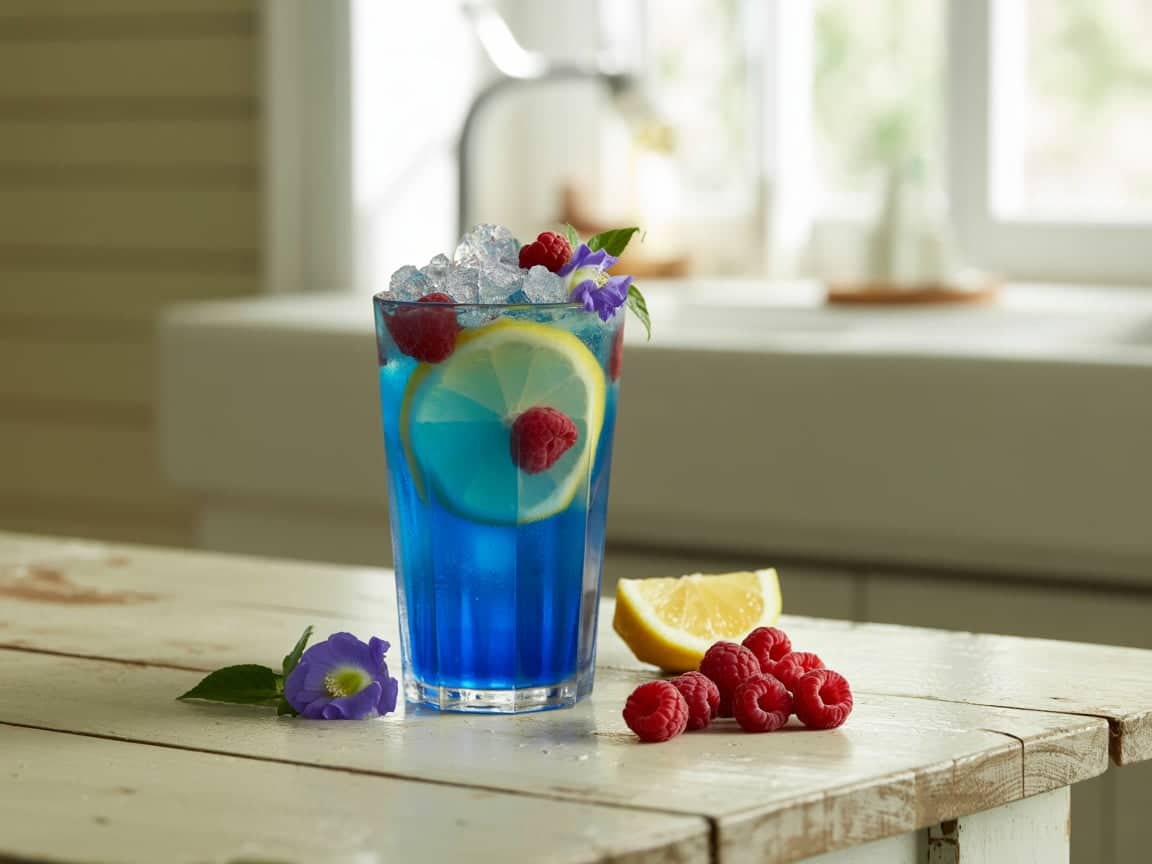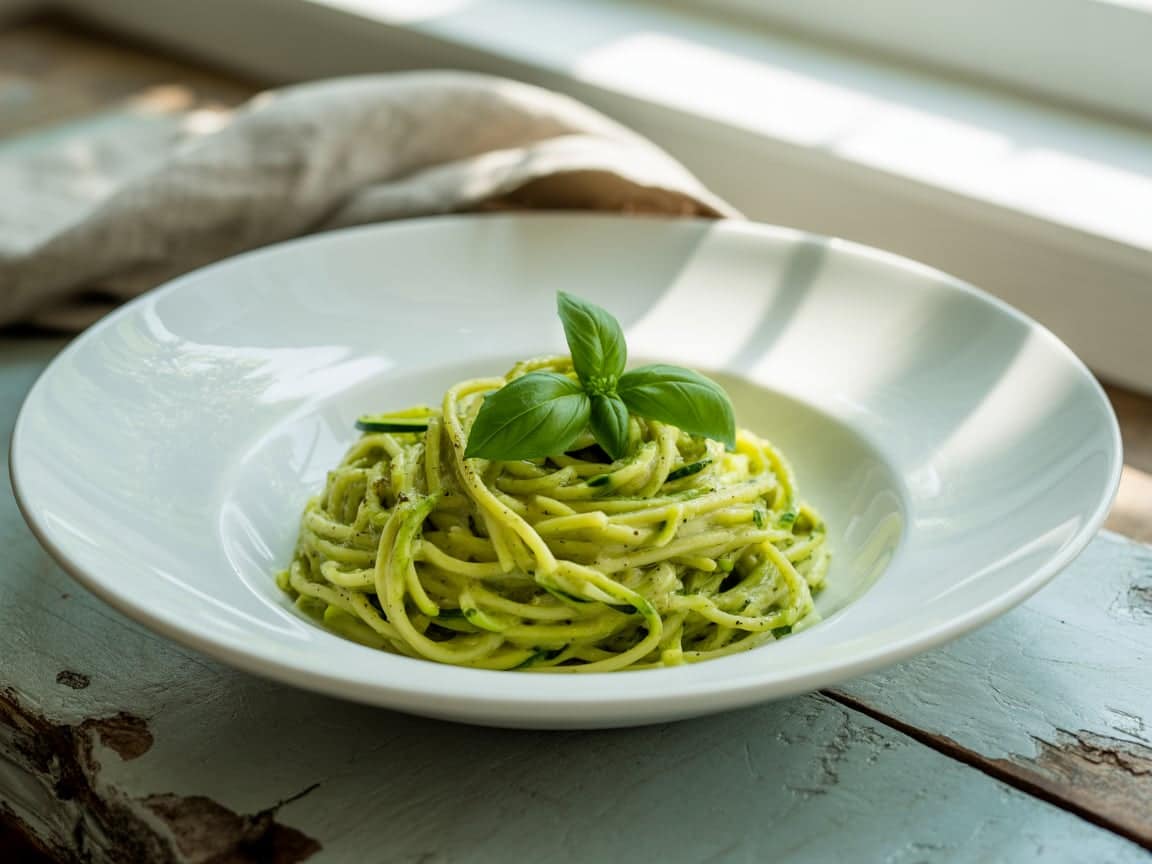Zobo drink holds a special place in my heart—and my kitchen. Long before CozyBitesRecipes.com ever existed, my love for creating meaningful meals began in my grandmother’s warm, bustling kitchen. As a child, I would watch her steep vibrant hibiscus petals into this ruby-red drink that she swore could soothe anything from a bad mood to an upset stomach. That early memory stuck with me—because zobo isn’t just a drink. It’s a tradition, a remedy, and a celebration of flavor.
Now, as a mom of two energetic kids and the creator behind CozyBitesRecipes.com, I still hold onto that same kitchen magic. At Cozy Bites, I focus on simple, comforting meals—recipes that nourish both body and soul. Zobo fits perfectly into that mission. Whether it’s for its natural detox properties, its ability to refresh on hot days, or the way it brings back memories of family and connection, this beautiful drink continues to be one of my all-time favorites.
In this article, I’ll walk you through everything you need to know about zobo drink—from its roots and health benefits to how you can make your own version at home with a flat tummy twist. You’ll also learn its many names, how it compares to other herbal drinks, and how to store it properly. Along the way, I’ll answer common questions like “Does zobo cleanse the body?” and “What’s the best way to make it for weight loss?”
Don’t miss our Liver Flush Juice Recipe for another delicious detox option that pairs well with zobo’s wellness benefits.
Let’s dive into the world of zobo—a drink filled with color, culture, and powerful health perks.
Table of Contents
What Is Zobo Drink? A Deep Dive into Its Origins and Name
Understanding Zobo: Cultural and Nutritional Background
Zobo drink, commonly known in Nigeria and across West Africa, is a vibrant, ruby-colored beverage made from the dried petals of the hibiscus plant—Hibiscus sabdariffa to be exact. It’s not just a refreshing drink; it’s a cornerstone of traditional wellness and celebration. You’ll often find it at family gatherings, weddings, and festive holidays, served chilled with a twist of citrus or ginger for an extra kick.
Rooted deeply in African culinary traditions, the zobo drink is more than just a thirst quencher. In many homes, it’s brewed with purpose—used to help lower blood pressure, aid digestion, and reduce inflammation. Passed down from generation to generation, the zobo drink continues to evolve, with each recipe reflecting personal taste and regional influence.
Made from dried hibiscus petals, the zobo drink is naturally rich in vitamin C, antioxidants, calcium, iron, and essential flavonoids. It’s caffeine-free and low in calories, making it a smart choice for anyone following a health-conscious lifestyle. When brewed with ingredients like ginger, cloves, pineapple peel, or citrus juice, it transforms into a flavorful powerhouse packed with immunity-boosting benefits.
Once a traditional West African beverage, the zobo drink has now gained international recognition. From detox juice routines to weight-loss programs, it’s being embraced far beyond its cultural roots for both its taste and wellness potential.
What Is Zobo Called in English? Hibiscus Tea Explained
So what exactly is zobo drink called in English? In most cases, zobo is referred to as “hibiscus tea” or “roselle drink.” While the name changes, the base ingredient remains the same—dried petals of the hibiscus flower. It’s sometimes confused with other herbal infusions like cranberry tea or rosehip tea due to its tangy flavor and vibrant hue, but hibiscus is unique in both composition and benefit.
In Jamaica, it’s called “sorrel.” In Mexico and Latin America, it goes by “agua de Jamaica.” In the Middle East, you might hear it called “karkade.” Despite the variations, these drinks all stem from the same botanical flower and are prepared using similar brewing techniques.
But “zobo” isn’t just hibiscus tea. It’s a culturally rich beverage that’s often enhanced with locally available ingredients like cloves, ginger root, cinnamon, or pineapple peel—each adding depth to both flavor and function.
Check out our Semolina Pudding Recipes for another cozy, traditional option with deep cultural roots.
As we move forward, you’ll see how this beautiful drink isn’t just about what’s in the cup—it’s about the stories and the science behind every sip. Next, we’ll look into its proven health benefits and how it fits into modern wellness routines.
Health Benefits of Zobo Drink Backed by Science
What Is Zobo Drink Good For?
If you’ve ever wondered why zobo drink remains a beloved staple across African households, the answer lies in its health-boosting profile. Zobo is more than just a traditional refreshment—it’s a natural wellness elixir loaded with proven benefits.
1. Supports Heart Health
Zobo drink is packed with anthocyanins, powerful antioxidants that may help lower blood pressure. According to research published by the American Heart Association, hibiscus tea significantly reduces systolic and diastolic blood pressure in pre-hypertensive adults. It works by relaxing blood vessels and improving circulation.
2. Boosts Immunity
Zobo is a great source of vitamin C, a crucial nutrient for maintaining immune system function. Combined with ingredients like ginger and pineapple peel, this drink provides added antiviral and antibacterial properties, perfect for warding off seasonal illnesses.
3. Helps Manage Weight Naturally
Drinking unsweetened zobo can support weight loss efforts, especially when paired with exercise and a clean diet. It acts as a natural diuretic, flushing excess fluids and toxins from the body, and may help reduce bloating.
4. Anti-inflammatory & Antioxidant Effects
The drink contains polyphenols and flavonoids which help fight inflammation and oxidative stress. These compounds are linked to a reduced risk of chronic diseases like diabetes and arthritis.
5. May Help Lower Cholesterol
Several studies suggest that regular consumption of hibiscus drinks can decrease LDL (bad cholesterol) while increasing HDL (good cholesterol), promoting a healthier lipid profile over time.
Zobo doesn’t just hydrate—you get real health support with every sip.
Looking for inspiration? Try High Protein Dense Bean Salad to pair with your zobo for a balanced, heart-friendly meal.
Does Zobo Cleanse the Body? Detox Facts and Myths
Yes, zobo drink is often praised for its detoxification properties, but let’s break it down with clarity.
Zobo as a Natural Diuretic
Zobo promotes urination, which helps rid the body of excess salt and water—flushing out toxins naturally. This is particularly helpful for people looking to reduce water retention or jumpstart a cleanse.
Liver-Friendly Compounds
Studies have shown that hibiscus may aid in protecting the liver, improving enzyme function, and reducing liver fat buildup in some individuals.
Debunking the Myth
While the zobo drink can support your body’s natural detox pathways, it’s important to remember that it’s not a magic fix. Instead, it should be enjoyed as a complement to a well-balanced diet and healthy lifestyle—not as a substitute for poor eating habits or lack of exercise.
When you pair the zobo drink with ingredients like ginger, pineapple juice, cloves, and black pepper, its detoxifying potential is enhanced. These additions help boost digestion, reduce inflammation, and support metabolism, making your zobo drink not only flavorful but functionally powerful.
Check out our Banana Peach Smoothie Recipe for another antioxidant-rich, gut-friendly drink to rotate with zobo in your weekly detox routine.
Zobo Drink Ingredients – Nature’s Healing in a Cup
Full Ingredient List and Their Health Benefits
The magic of zobo drink lies in its simple, nutrient-dense ingredients—all of which are easy to find and deeply beneficial for your health. Each component serves a purpose, not just for flavor, but for supporting your overall wellness.
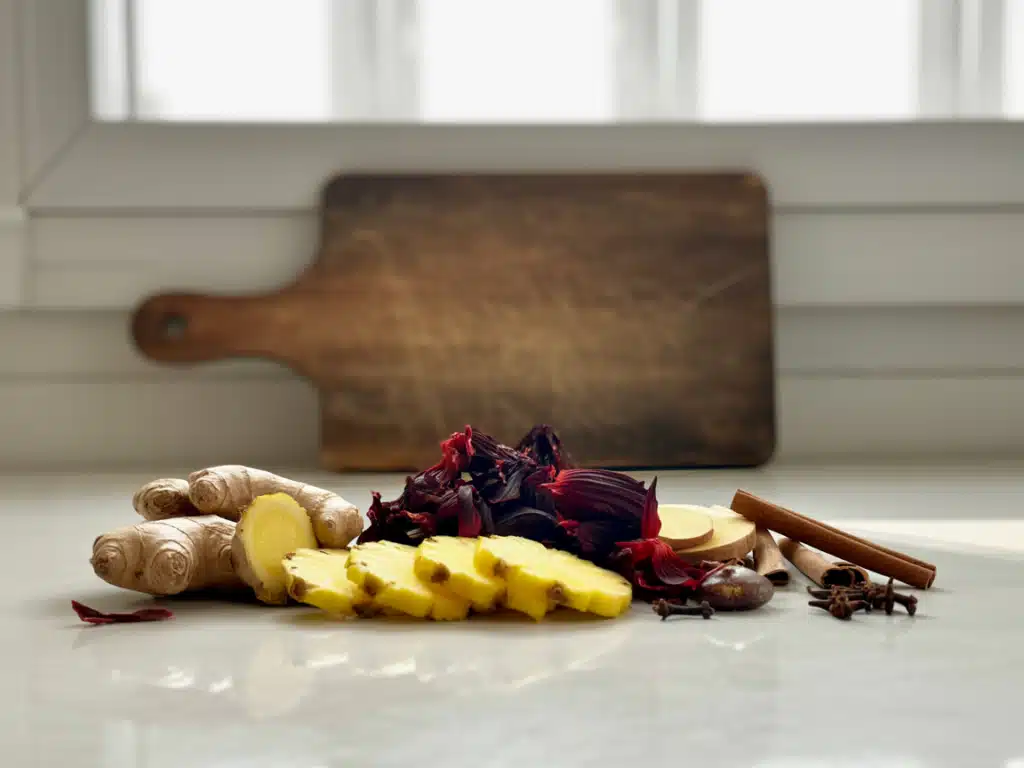
Here’s the ingredient list used in the Cozy Bites version of zobo, along with their proven benefits:
| Ingredient | Health Benefit |
|---|---|
| Dried Hibiscus Petals (Zobo Leaves) | Rich in antioxidants, supports blood pressure regulation |
| Water | Hydration, detoxification |
| Pineapple Peel (optional) | Aids digestion, contains bromelain enzyme for inflammation |
| Pineapple Juice | Adds vitamin C, helps metabolism |
| Ginger Root (blended) | Anti-inflammatory, aids digestion, boosts immunity |
| Cloves (optional) | Antimicrobial, helps gut health |
| Cinnamon Stick | Regulates blood sugar, antioxidant-rich |
| Black Peppercorns | Enhances nutrient absorption, aids in detox |
| Orange Juice (optional) | Adds citrus zest and vitamin C boost |
| Ice Cubes | Just for refreshing chill! |
All these ingredients come together to create a drink that’s not just delicious, but also functional. The real beauty? You can tweak this recipe to suit your specific health needs or taste preferences.
Nutritional Values and Natural Compounds Found in Zobo Drink
Let’s break down the nutritional profile of the core components in a typical zobo drink. Here’s what makes it such a potent natural remedy:
- Low in Calories: Without added sugars, zobo remains a low-calorie beverage.
- Vitamin C Boost: A single glass delivers a significant portion of your daily recommended intake.
- Rich in Antioxidants: Especially anthocyanins, which fight cell damage.
- Anti-inflammatory Agents: Ginger, cinnamon, and hibiscus all work together to soothe inflammation and promote healing.
- Mild Diuretic Effect: Helps flush excess fluids, reducing bloating.
Drinking zobo regularly can support everything from heart health to digestive wellness. It’s like sipping on liquid vitality—with zero artificial additives.
Discover great ideas like Natural Zepbound Recipe if you love drinks with functional health benefits.
Next, we’ll show you how to make zobo right in your own kitchen—with all the tips for freshness and flavor.
How to Make Zobo Drink at Home (Step-by-Step Guide)
Traditional Zobo Recipe with Modern Healthy Tweaks
Making zobo drink at home is easier than you think—and it’s fully customizable. Whether you like yours tangy, spicy, fruity, or light, this recipe can be tailored to fit your taste buds and wellness goals. Here’s a classic take on how to brew zobo with a few healthy tweaks straight from my kitchen.
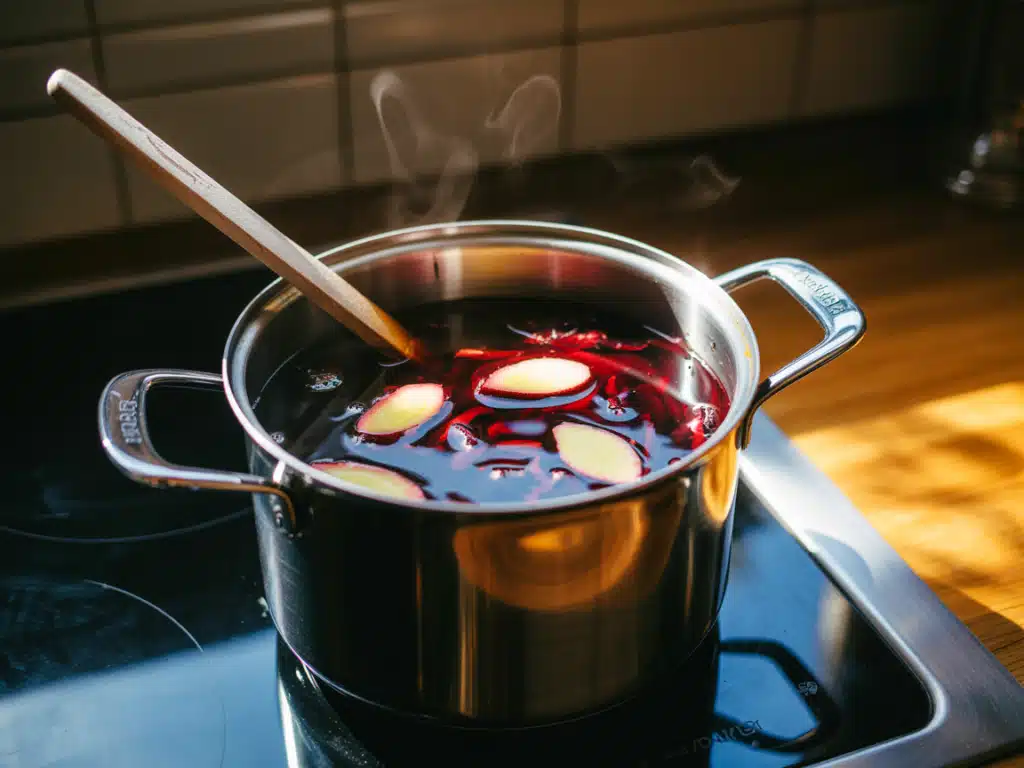
Ingredients:
- 2 cups dried hibiscus petals (zobo leaves)
- 8 cups water
- 1 cup pineapple peel (optional)
- 3–4 cups pineapple juice (adjust to taste)
- 1–2 fresh ginger roots, blended (adjust to taste)
- 2–3 cloves (optional)
- 1 cinnamon stick
- 1 tsp black peppercorn
- 1–2 cups orange juice (optional)
- Ice cubes for serving
Instructions:
- Prep the Zobo Leaves
Rinse the dried hibiscus petals thoroughly under running water to remove dust and grit. - Boil the Base
In a large pot, add hibiscus petals, ginger, cloves, cinnamon, black peppercorn, pineapple peel, and water. Bring to a boil. - Simmer for Flavor
Reduce heat and let the mixture simmer for 10–15 minutes. This allows the spices and petals to infuse deeply. - Cool and Strain
Remove the pot from heat and let it cool to room temperature. Strain the mixture through a fine mesh sieve or cheesecloth, pressing to extract as much juice as possible. - Add Fresh Juices
Stir in the pineapple and orange juice for extra zest and natural sweetness. Mix well. - Chill or Serve Over Ice
Refrigerate for a few hours or serve immediately over ice for a refreshing experience.
This method combines traditional preparation with nutrient-dense enhancements—no need for artificial sweeteners or preservatives.
Print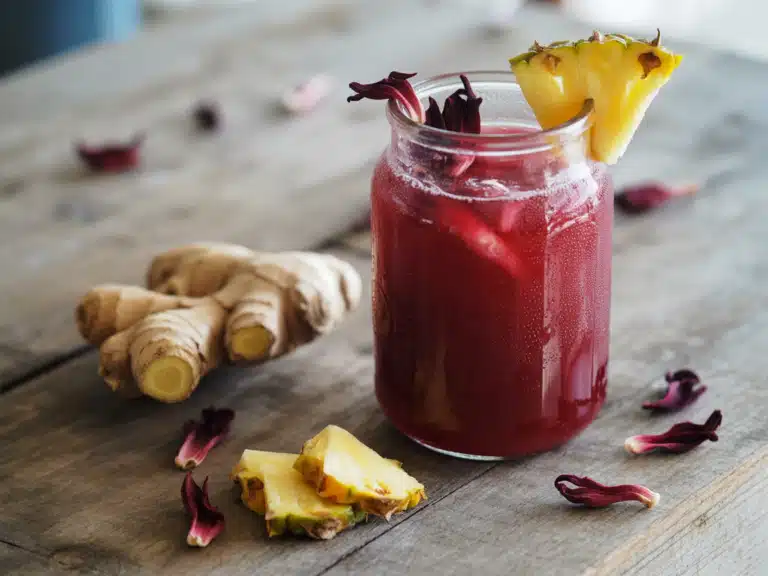
Zobo Drink Recipe
This refreshing zobo drink recipe is a traditional West African beverage made from dried hibiscus petals and infused with natural spices like ginger, cloves, and citrus. Packed with antioxidants and vitamin C, it’s perfect for cooling off, boosting immunity, or supporting gentle detox. Naturally caffeine-free, slightly tangy, and totally customizable—this vibrant drink is a delicious way to nourish your body.
- Total Time: 20 minutes
- Yield: 6–8 servings 1x
Ingredients
2 cups Dried Hibiscus petals (Zobo leaves)
8 cups Water
1 cup Pineapple peel optional
3–4 cups Pineapple juice Adjust to taste
1–2 Ginger root blended Adjust to taste
2–3 Cloves optional
1 Cinnamon stick
1 tsp Black pepper corn
1–2 cupa Orange juice optional
Ice cubes
Instructions
Rinse the dried hibiscus petals thoroughly under running water.
Add the hibiscus petals, ginger, clove, black pepper, pineapple peel, cinnamon and water in a pot. Bring to a boil, reduce the heat and simmer for 10-15 minutes.
Remove the pot from heat and let the mixture cool to room temperature.
Strain the liquid through a fine-mesh sieve or cheesecloth into a clean container to remove the hibiscus petals, pressing to extract all the juice.
Add the pineapple and orange juice to the strained hibiscus juice.
Chill the Zobo drink in the refrigerator for a few hours or serve over ice cubes.
Notes
Sweetener Options: You can use honey, agave, date syrup, or stevia to sweeten your zobo drink naturally. Adjust to taste.
Flavor Boosters: Add pineapple juice, fresh mint, or a splash of lime for extra flavor and health benefits.
Storage Tip: Store in the refrigerator for up to 5–7 days. It tastes even better the next day!
Caution: Zobo may lower blood pressure. Consult your doctor if pregnant or on medication before regular consumption.
Serving Suggestion: Serve over ice or chilled with a citrus slice for a refreshing twist.
- Prep Time: 15 minutes
- Cook Time: 5 minutes
- Diet: Gluten Free
Nutrition
- Serving Size: 6–8 servings
- Calories: ~50–80 kcal
Preparation, Storage, and Serving Tips
Here’s how to get the most out of your zobo drink from batch to glass:
Preparation Tips:
- Use fresh ingredients: For optimal health benefits and taste, always use freshly peeled ginger, ripe pineapple, and citrus juices.
- Adjust sweetness naturally: If needed, sweeten with natural alternatives like dates, honey, or stevia instead of sugar.
Storage Tips:
- Store zobo in glass containers in the refrigerator.
- Keeps fresh for up to 5–7 days if refrigerated immediately after cooling.
- For longer storage, pour into ice cube trays and freeze—perfect for adding to smoothies or cold water.
Serving Suggestions:
- Serve cold with citrus slices or mint sprigs for a classy touch.
- Pair with light snacks like puff-puff, grilled veggies, or Check out our Natural Mounjaro Recipe for a delicious low-carb side option.
Whether you’re serving guests or enjoying a quiet moment on the porch, zobo is always a hit in a glass.
Zobo for Weight Loss – Flat Tummy Detox Version
How to Make Zobo for a Flat Tummy
One of the most talked-about benefits of zobo drink is its potential to help with weight loss, especially for those targeting stubborn belly fat. When combined with the right ingredients and lifestyle, zobo can support a flatter tummy by reducing bloating, boosting metabolism, and improving digestion.
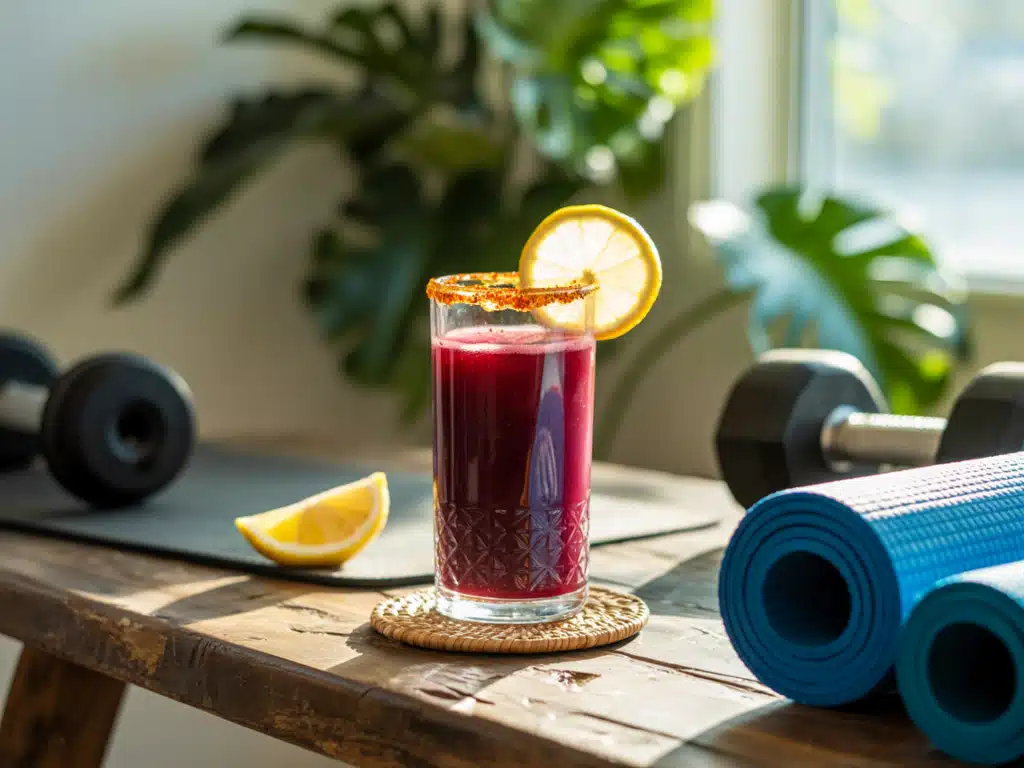
Here’s how to tailor your zobo recipe for weight management:
Flat Tummy Zobo Ingredients:
- 2 cups dried hibiscus petals
- 1 tablespoon freshly grated ginger (more for stronger effect)
- 2–3 cups water
- 1 cup pineapple juice (fresh, unsweetened)
- Juice of 1 lemon or 1 orange
- 1 teaspoon apple cider vinegar (optional)
- A pinch of cayenne pepper (optional fat-burning boost)
- No sugar or sweetener
Instructions:
- Rinse hibiscus petals and add to boiling water along with ginger.
- Simmer for 10 minutes and allow to cool.
- Strain, then add citrus juice and a splash of ACV or cayenne if using.
- Serve chilled before meals or first thing in the morning.
This blend promotes fat burning, metabolism stimulation, and fluid balance. Ginger revs up your internal heat, hibiscus flushes excess water, and pineapple and citrus aid digestion.
✅ Drink this detox version 3–4 times per week, especially in the morning or before meals for best results.
Other Natural Fat-Burning Add-ons
Want to dial up the detox and flatten your stomach faster? These ingredients work well when added to zobo—or alternated in your routine:
- Cucumber Juice: Contains silica and antioxidants that reduce water retention.
- Lemon & Mint: Alkalizing and digestive-supporting duo.
- Apple Cider Vinegar: Balances pH, suppresses appetite.
- Cayenne Pepper: Contains capsaicin, which boosts metabolism.
- Fennel Seeds: Soothes the gut and reduces bloating.
Always remember—no drink is a miracle worker alone. Combine zobo with regular exercise, portion control, and clean eating for the best results.
Don’t miss our Purple Peel Recipe for another tummy-flattening natural option to add to your wellness rotation.
Zobo Drink Variations You Should Try
Pineapple, Orange, and Ginger Combo
One of the best things about zobo drink is how easy it is to customize. The classic version is refreshing on its own, but when you combine it with tropical fruits and bold spices, you take the flavor—and the health benefits—to the next level.
Why This Combo Works:
- Pineapple: Adds natural sweetness and a tropical vibe. It’s also packed with bromelain, which supports digestion and reduces inflammation.
- Orange Juice: Brings a citrusy brightness and a healthy dose of vitamin C.
- Ginger: A warming spice that balances the tartness of hibiscus while boosting metabolism and aiding digestion.
This combination not only tastes great but also transforms your zobo into a vibrant, immune-boosting elixir. You can even add a cinnamon stick during the boiling stage for a cozy, spiced twist.
Quick Recipe Tip:
For a refreshing twist, blend fresh pineapple with a little orange juice and stir it into your chilled zobo concentrate. Add thin slices of ginger before serving and let it steep for a few minutes before drinking.
Perfect for brunches, outdoor gatherings, or as a post-workout refresher.
Looking for inspiration? Try Pink Salt Recipe—a flavorful companion to your tropical zobo mix.
Non-Sugar Options for Diabetics and Keto Dieters
If you’re avoiding sugar for health reasons like diabetes or following a low-carb lifestyle, zobo can still be part of your routine. The key is to skip sweeteners and lean into the natural flavor profile of hibiscus, citrus, and spice.
Here’s how to make it work:
Diabetic-Friendly Zobo:
- Use freshly juiced citrus instead of sweetened juice blends.
- Add cinnamon and cloves, which may help stabilize blood sugar.
- Avoid commercial sweeteners; opt for stevia or monk fruit if necessary.
Keto Zobo Adjustments:
- Skip fruit juices entirely and use infused water (think mint, cucumber, or lemon).
- Add MCT oil or a keto electrolyte blend for added energy and hydration.
- Drink it before meals to help reduce sugar cravings and boost satiety.
Pro tip: Serve your keto-friendly zobo over ice with a twist of lime and a pinch of sea salt—delicious and hydrating.
Check out our Brazilian Mounjaro Recipe for another creative, nutrient-focused beverage alternative.
Zobo can be as simple or as elevated as you like—from a detox drink to a festive party punch, it’s a flexible favorite for every lifestyle.
Risks and Side Effects of Overconsuming Zobo Drink
Can You Drink Too Much Zobo?
Zobo drink is packed with benefits—but as with anything healthy, too much of a good thing can become a problem. While moderate consumption (1–2 glasses per day) is typically safe for most people, drinking it excessively can lead to unwanted side effects.
Potential Issues from Overconsumption:
- Low Blood Pressure (Hypotension)
Hibiscus has natural blood pressure-lowering effects. Overconsumption—especially by individuals already on hypertension meds—can cause dizziness, fatigue, or even fainting. - Liver Strain
Some studies have shown that drinking large amounts of concentrated hibiscus tea could impact liver enzymes. This is more likely with long-term, daily intake in high volumes (more than 1 liter per day). - Mild Hallucinogenic Effects
Though rare, some users have reported feeling light-headed or slightly euphoric after drinking large quantities of zobo due to hibiscus’ impact on the central nervous system. - Interaction with Medications
Zobo may interfere with medications like diuretics, ACE inhibitors, and aspirin. If you’re on prescription meds, consult your doctor before making zobo a daily habit. - Dental Enamel Erosion
Like most acidic drinks, zobo can wear down tooth enamel if sipped throughout the day without rinsing or brushing afterward.
Moderation is key. Most of these issues are only associated with daily, high-volume use, especially when the drink is highly concentrated or not diluted.
When to Avoid Zobo – Pregnancy, Ulcers & Interactions
Zobo may be natural, but it’s not for everyone—particularly during sensitive stages like pregnancy or for those with digestive issues.
Who Should Avoid or Limit Zobo:
- Pregnant Women
Hibiscus has been linked to potential uterine stimulation, which may increase the risk of miscarriage or premature labor. It’s strongly advised to avoid zobo during pregnancy. - People with Stomach Ulcers
The acidity of hibiscus may worsen symptoms in those with gastric ulcers or acid reflux. - Individuals on Blood Thinners
Zobo contains salicylates (aspirin-like compounds), which may interfere with blood-thinning medications. - Children Under 5
Due to its potency and possible allergenic reactions, it’s better to serve a highly diluted version or consult a pediatrician.
Best Practice:
Enjoy zobo 2–4 times per week in moderation. Drink it cold, freshly made, and preferably alongside food to balance acidity.
Zobo is amazing—but your body thrives on variety. Rotate it with drinks like our Don’t miss our Liver Flush Juice Recipe to keep your wellness routine balanced and exciting.
Zobo Drink vs Other Herbal Drinks
Zobo vs Lemon Balm, Tamarind, and Detox Juices
While zobo drink stands out with its bold color and tangy flavor, it isn’t the only herbal beverage making waves in wellness circles. Let’s see how it stacks up against other popular natural drinks.
| Drink | Key Ingredient | Flavor Profile | Top Benefits |
|---|---|---|---|
| Zobo (Hibiscus) | Dried hibiscus petals | Tangy, fruity | Lowers BP, antioxidant, detox |
| Lemon Balm Tea | Lemon balm leaves | Mild, citrusy | Calming, reduces anxiety, aids sleep |
| Tamarind Juice | Tamarind pulp | Sweet-tart | Aids digestion, rich in magnesium |
| Cucumber-Mint Detox Water | Cucumber & mint | Refreshing, light | Hydrating, reduces bloating |
| Apple Cider Vinegar Drink | ACV + lemon | Sour, sharp | Gut health, metabolism booster |
Zobo delivers a balanced mix of detox, hydration, and blood pressure support, while also offering a satisfying taste that works great in social settings or health regimens. Where lemon balm is calming and tamarind supports digestion, zobo targets multiple health areas in one refreshing glass.
Another win? Zobo is far more versatile—you can spice it up with ginger, cool it with citrus, or even blend it into smoothies.
Check out our Lemon Balm Recipe for a milder herbal alternative that pairs beautifully with zobo on alternating days.
How Zobo Compares in Taste, Benefits, and Usage
Taste:
Zobo boasts a bold, floral-tart flavor with a deep crimson color. It’s more robust than many other herbal teas, which makes it a favorite among those who like a punchy beverage without added sugar.
Health Benefits:
Unlike some herbal drinks that focus on just one benefit (e.g., digestion, relaxation), zobo provides a multi-faceted approach:
- Blood pressure control
- Immune support
- Detoxification
- Weight loss aid
- Antioxidant protection
Usage:
Zobo is one of the few herbal drinks that can be:
- Served hot or cold
- Enhanced with spices, herbs, or juices
- Made in large batches and stored
- Used as a non-alcoholic punch for parties
From its flexibility to its functional health perks, zobo holds its own—and often surpasses—many other herbal drinks in both wellness and cultural value.
How to Store and Preserve Zobo for Long-Lasting Freshness
Shelf Life Tips: Fridge, Freezing, and Pasteurization
Once you’ve brewed a rich, refreshing batch of zobo drink, the next step is ensuring it stays fresh and safe to consume. Zobo is made from natural ingredients, which means it’s prone to spoilage if not stored correctly.
Here’s how to preserve your zobo for maximum shelf life without compromising flavor or nutrients:
Refrigeration (Short-Term)
- Store in glass bottles or mason jars with tight lids to prevent air exposure.
- Keep in the coldest part of your fridge (not the door).
- Lasts 5 to 7 days if made without sugar and stored properly.
- For zobo with added fresh juice, drink within 3–4 days for best taste.
Freezing (Long-Term)
- Freeze in ice cube trays for smoothie boosters or chillers.
- Pour into BPA-free freezer bags or containers, leaving room for expansion.
- Can be stored frozen for up to 3 months.
- Thaw in the fridge overnight and shake well before drinking.
Pasteurization (Extended Shelf Life)
If you’re making zobo for commercial purposes or gifting:
- Reheat strained zobo to 185°F (85°C) without boiling.
- Pour into sterilized glass bottles and seal immediately.
- Store in a cool, dark place or refrigerate.
- This process can extend shelf life up to 2–3 weeks unopened.
Important Tip: Never leave zobo at room temperature for extended periods. Fermentation can occur, altering both taste and safety.
Best Practices to Retain Nutritional Value
To keep your zobo drink both potent and delicious, follow these guidelines:
- Avoid metal containers for storage—opt for food-safe glass instead.
- Don’t reboil zobo after adding fresh juice; heat can destroy vitamin C and delicate antioxidants.
- Use clean utensils when scooping or pouring to avoid bacterial contamination.
- Add citrus juice after cooling to retain full enzymatic power.
Storing zobo the right way means you’ll always have a refreshing, healthy option ready to go. Whether it’s a weekday detox or a weekend cooler, well-preserved zobo keeps both the flavor and the wellness flowing.
Check out our Natural Mounjaro Recipe for another long-lasting, nutrient-rich homemade drink option.
FAQ – Frequently Asked Questions About Zobo Drink
What is Zobo drink good for?
Zobo drink is good for lowering blood pressure, boosting immunity, supporting digestion, and aiding weight loss. Thanks to its high antioxidant and vitamin C content, it also helps fight inflammation and oxidative stress. It’s particularly beneficial for people looking to detox naturally, improve hydration, and enjoy a caffeine-free energy lift. When brewed with ingredients like ginger and pineapple, it becomes a potent health tonic that supports metabolism and overall wellness.
What is Zobo called in English?
In English, zobo is commonly referred to as hibiscus tea or hibiscus drink. It’s made from the dried calyces of the hibiscus flower, specifically Hibiscus sabdariffa. Globally, it goes by different names: “agua de Jamaica” in Mexico, “sorrel” in the Caribbean, and “karkade” in North Africa and the Middle East. No matter the name, the base ingredient and the method of preparation remain largely the same.
Does Zobo cleanse the body?
Yes, zobo drink acts as a mild natural cleanser by supporting the body’s natural detox processes. Its diuretic properties encourage frequent urination, helping flush out excess salt and toxins. The antioxidants in hibiscus also support liver function, and when paired with citrus juice, ginger, or cloves, the drink becomes a holistic detoxifier. However, it works best as part of a balanced lifestyle—not as a standalone detox solution.
How to make Zobo for a flat tummy?
To make zobo for a flat tummy, use the base of hibiscus petals with powerful add-ins like ginger, pineapple juice, lemon juice, and a pinch of cayenne pepper or apple cider vinegar. Avoid added sugars and serve it chilled before meals or in the morning. This version helps reduce bloating, curb appetite, and increase metabolism, making it an ideal companion to your weight loss efforts. Drink 3–4 times a week for noticeable results.
Conclusion – Is Zobo Drink Worth Adding to Your Daily Routine?
Absolutely—zobo drink is one of those rare beverages that brings together bold flavor, deep cultural roots, and real health benefits. Whether you’re enjoying it to hydrate, lower blood pressure, cleanse your system, or slim your waistline, zobo fits right into a modern, wellness-focused lifestyle.
From the vibrant color of hibiscus petals to the immune-boosting powers of ginger and citrus, every sip of a zobo drink delivers something beneficial. It’s also incredibly versatile—you can adjust the ingredients to match your taste preferences, sweeten it naturally, or even transform it into a refreshing weight-loss detox option.
That said, while the zobo drink offers plenty of health perks, it’s important to enjoy it in moderation. Be mindful of any personal health conditions, especially if you’re pregnant or taking medications, as hibiscus can interact with certain treatments.
If you’re someone who loves combining traditional flavors with functional wellness, zobo drink deserves a permanent place in your fridge.
Don’t miss our Bariatric Seed Recipe for another nutrient-packed option that pairs well with zobo in your weekly routine.
So whether you’re sipping it chilled on a summer day or adding it to your detox rotation, zobo is more than just a drink—it’s a healthy habit steeped in heritage.


